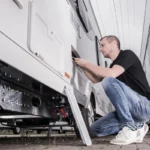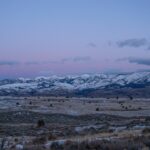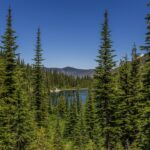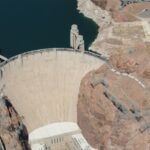Overlanding is a form of travel that combines off-roading and camping, allowing adventurers to explore remote and rugged areas that are inaccessible by traditional means of transportation. It is a self-reliant and immersive way to experience the great outdoors, providing an opportunity to disconnect from the modern world and connect with nature. One destination that is perfect for overlanding is Oregon’s backcountry, with its diverse landscapes, stunning scenery, and abundance of outdoor activities.
Oregon’s backcountry offers a wide range of terrain, from coastal dunes to towering mountains, making it an ideal destination for overlanding enthusiasts. The state is known for its vast wilderness areas, including the Cascade Range, the Columbia River Gorge, and the Oregon Coast. These areas provide endless opportunities for exploration and adventure, with miles of off-road trails, scenic byways, and hidden gems waiting to be discovered.
Essential Gear and Preparations for Overlanding in the Wild West
Before embarking on an overlanding adventure in Oregon’s backcountry, it is important to have the right gear and make necessary preparations. The first step is choosing the right vehicle for overlanding. A 4×4 vehicle with good ground clearance and off-road capabilities is essential for navigating rugged terrain. It is also important to ensure that the vehicle is in good mechanical condition and equipped with all-terrain tires.
In addition to a suitable vehicle, there are several essential gear items that every overlander should have. These include recovery equipment such as a winch, recovery straps, and a shovel, as well as basic tools for vehicle maintenance. Other important gear includes camping equipment such as a tent, sleeping bags, cooking utensils, and a portable stove. It is also crucial to have a reliable navigation system, such as GPS or maps, as well as a first aid kit and emergency supplies.
Preparing for emergencies is a crucial part of overlanding. It is important to have a plan in case of vehicle breakdowns, medical emergencies, or other unexpected situations. This includes carrying extra food and water, having a means of communication such as a satellite phone or a two-way radio, and knowing basic first aid skills. It is also important to let someone know about your travel plans and expected return date, so that they can alert authorities if necessary.
Navigating Oregon’s Backcountry: Tips and Tricks for Safe and Successful Overlanding
Navigating the backcountry of Oregon requires some knowledge and skills to ensure a safe and successful overlanding experience. Understanding the terrain is crucial, as it can vary greatly depending on the region. It is important to research the area beforehand and familiarize yourself with the types of terrain you may encounter, such as sand dunes, rocky trails, or muddy roads.
Having the right navigation tools and techniques is essential for successful overlanding. GPS devices are useful for tracking your location and navigating off-road trails, but it is also important to have backup navigation tools such as maps and compasses in case of technical failures. It is also helpful to learn basic orienteering skills, such as reading topographic maps and using landmarks for navigation.
Dealing with unexpected challenges is part of the adventure of overlanding. It is important to be prepared for obstacles such as fallen trees, washed-out roads, or unexpected weather conditions. Having the right recovery equipment, such as a winch and recovery straps, can help you get out of sticky situations. It is also important to have a backup plan in case your intended route becomes impassable, such as having alternative routes or destinations in mind.
The Best Overlanding Routes in Oregon: From the Coast to the Mountains
| Route Name | Distance (miles) | Difficulty | Duration (days) | Highlights |
|---|---|---|---|---|
| Coast Range Traverse | 150 | Difficult | 5-7 | Stunning coastal views, old-growth forests, waterfalls |
| Steens Mountain Loop | 200 | Moderate | 3-5 | Wildlife viewing, hot springs, Alvord Desert |
| Wallowa Mountains Backcountry | 100 | Difficult | 4-6 | Alpine lakes, granite peaks, Hells Canyon overlooks |
| Central Oregon Backcountry Discovery Route | 800 | Moderate | 7-10 | High desert landscapes, lava fields, hot springs |
| Umpqua National Forest | 150 | Moderate | 3-5 | Waterfalls, hot springs, old-growth forests |
Oregon offers a wide range of overlanding routes that showcase its diverse landscapes and natural beauty. From coastal routes to mountain trails, there is something for every overlander in this wild west state.
Coastal routes in Oregon provide a unique overlanding experience, with miles of sandy beaches, towering cliffs, and stunning ocean views. The Oregon Coast Highway, also known as Highway 101, is a popular route that stretches along the entire length of the state’s coastline. This scenic highway offers numerous opportunities for camping, hiking, and exploring coastal towns and attractions.
For those seeking a mountain adventure, the Cascade Range in Oregon is a must-visit. The Cascade Lakes Scenic Byway is a popular route that takes you through the heart of the Cascade Mountains, passing by numerous alpine lakes, volcanic peaks, and lush forests. This route offers plenty of opportunities for camping, fishing, hiking, and wildlife viewing.
If you’re looking for a scenic overlanding route that showcases the best of Oregon’s landscapes, the Columbia River Gorge is a great choice. This dramatic river canyon is home to numerous waterfalls, hiking trails, and scenic viewpoints. The Historic Columbia River Highway is a scenic byway that takes you through the heart of the gorge, offering breathtaking views of waterfalls such as Multnomah Falls and scenic overlooks such as Crown Point.
Exploring Oregon’s Wild West: Wildlife, Landscapes, and Hidden Gems
Oregon’s backcountry is home to a diverse range of wildlife and landscapes, making it a paradise for nature lovers and outdoor enthusiasts. From majestic elk to elusive mountain lions, there is always a chance to encounter wildlife while overlanding in Oregon.
The state’s landscapes are equally stunning, with towering mountains, lush forests, pristine lakes, and rugged coastlines. Whether you’re exploring the high desert of eastern Oregon or the lush rainforests of the coast, there is always something new and beautiful to discover.
In addition to its well-known attractions, Oregon’s backcountry is also home to hidden gems that are off the beaten path. These hidden gems include secluded campsites, hidden waterfalls, and lesser-known hiking trails. Exploring these hidden gems can provide a sense of adventure and discovery, allowing you to experience the true wilderness of Oregon.
Camping in the Backcountry: Finding the Perfect Spot and Setting Up Camp
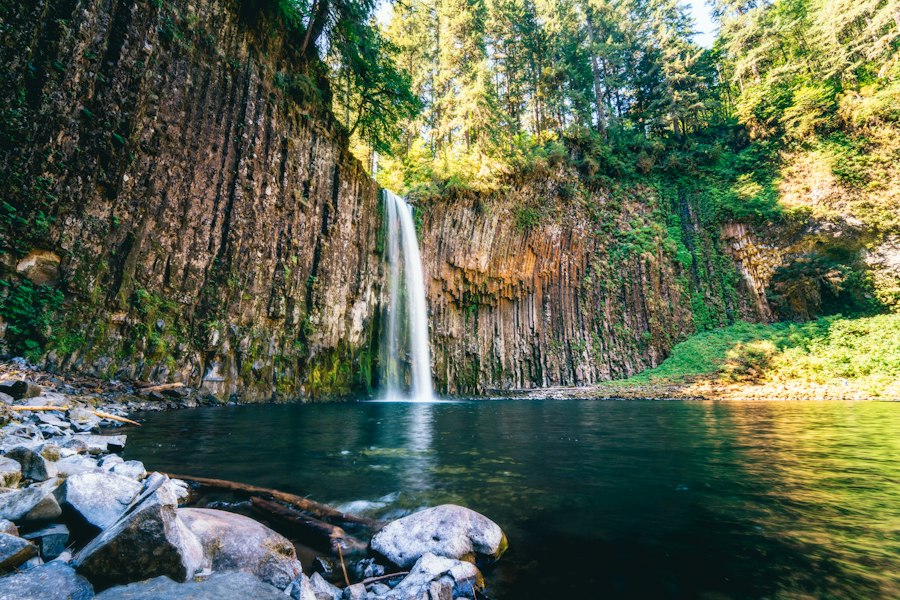
Camping is an integral part of the overlanding experience, allowing you to immerse yourself in nature and enjoy the solitude of the backcountry. When camping in Oregon’s backcountry, it is important to choose the right campsite and set up camp responsibly.
When choosing a campsite, it is important to consider factors such as accessibility, privacy, and natural beauty. Look for campsites that are away from main roads and popular attractions, as these tend to be more crowded. It is also important to choose a campsite that is environmentally friendly, avoiding sensitive areas such as meadows or fragile ecosystems.
Setting up camp responsibly is crucial for minimizing your impact on the environment. Follow Leave No Trace principles, which include packing out all trash, minimizing campfire impacts, and respecting wildlife and other visitors. It is also important to set up your campsite in a way that minimizes your impact on the surrounding environment, such as using existing fire rings or designated campsites.
Campfire safety is another important aspect of camping in the backcountry. Before starting a campfire, check for any fire restrictions or bans in the area. If campfires are allowed, make sure to use designated fire rings or build a fire pit using rocks. Always keep a bucket of water or a fire extinguisher nearby and never leave a campfire unattended.
Cooking and Eating on the Road: Overlanding Meal Ideas and Tips
One of the joys of overlanding is being able to cook and eat delicious meals while on the road. With some planning and preparation, you can enjoy tasty and nutritious meals even in the remote backcountry of Oregon.
Meal planning is an important part of overlanding. Before your trip, make a list of meals and snacks that you want to prepare and pack accordingly. Consider the duration of your trip, the number of people in your group, and any dietary restrictions or preferences. It is also important to pack non-perishable food items that can be easily stored and prepared in the backcountry.
When it comes to cooking equipment, simplicity is key. Opt for lightweight and compact cooking gear that can be easily packed and set up. A portable stove or campfire grill is essential for cooking meals, while a set of pots, pans, and utensils will allow you to prepare a variety of dishes. Don’t forget to pack essentials such as a cutting board, knife, and can opener.
When it comes to meal ideas, the possibilities are endless. From simple one-pot meals to gourmet campfire cooking, there are plenty of options for every taste and skill level. Some popular overlanding meal ideas include chili, stir-fry, pasta dishes, and foil-wrapped meals cooked over the campfire. Don’t forget to pack snacks such as trail mix, energy bars, and fresh fruits for quick and easy fuel on the go.
Overlanding with a Purpose: Conservation and Sustainability in Oregon’s Backcountry
As overlanders, it is important to practice conservation and sustainability in order to protect the natural beauty of Oregon’s backcountry for future generations. By following Leave No Trace principles and adopting sustainable overlanding practices, we can minimize our impact on the environment and support local conservation efforts.
Leave No Trace principles provide guidelines for responsible outdoor recreation. These principles include packing out all trash, minimizing campfire impacts, respecting wildlife and other visitors, staying on designated trails, and leaving natural and cultural artifacts undisturbed. By following these principles, we can ensure that the backcountry remains pristine and unspoiled.
Sustainable overlanding practices go beyond Leave No Trace principles and involve making conscious choices to reduce our environmental footprint. This can include using reusable water bottles and food containers, using biodegradable soaps and cleaning products, conserving water and energy, and supporting local businesses and conservation organizations.
Supporting local conservation efforts is another way to give back to the places we explore. Consider volunteering for trail maintenance projects, participating in clean-up events, or donating to local conservation organizations. By supporting these efforts, we can help preserve the natural beauty of Oregon’s backcountry for future generations to enjoy.
Overlanding Safety: Dealing with Emergencies and Staying Safe in the Wild West
While overlanding in Oregon’s backcountry can be an exhilarating adventure, it is important to prioritize safety and be prepared for emergencies. By taking necessary precautions and being prepared for unexpected situations, you can ensure a safe and enjoyable overlanding experience.
First aid essentials are crucial for dealing with medical emergencies in the backcountry. Make sure to pack a well-stocked first aid kit that includes essentials such as bandages, antiseptic ointment, pain relievers, and any necessary prescription medications. It is also important to have basic knowledge of first aid techniques, such as CPR and treating common injuries.
Dealing with vehicle breakdowns is another potential challenge while overlanding. It is important to have a basic understanding of vehicle maintenance and repair, as well as carrying essential tools and spare parts. It is also helpful to have a plan in case of breakdowns, such as having a roadside assistance service or knowing how to contact local mechanics or tow services.
Staying safe in the wilderness requires some basic knowledge and skills. It is important to be aware of potential hazards such as wildlife encounters, extreme weather conditions, or hazardous terrain. Carry bear spray or other deterrents if you are in bear country, and know how to react in case of an encounter. Be prepared for changing weather conditions by packing appropriate clothing and gear, and always check weather forecasts before heading out. Finally, it is important to stay on designated trails and follow any safety guidelines or regulations in the area.
Why Overlanding in Oregon’s Backcountry is an Adventure of a Lifetime
Overlanding in Oregon’s backcountry offers a unique and immersive way to experience the beauty and wilderness of this wild west state. From the stunning landscapes to the diverse wildlife, there is something for every outdoor enthusiast in Oregon.
By choosing the right vehicle, having essential gear, and making necessary preparations, you can ensure a safe and successful overlanding adventure. Navigating the backcountry requires some knowledge and skills, but with the right tools and techniques, you can explore remote areas with confidence.
Whether you choose to explore coastal routes, mountain trails, or scenic byways, Oregon offers a wide range of overlanding routes that showcase its natural beauty. From hidden gems to well-known attractions, there is always something new and exciting to discover.
Camping in the backcountry allows you to immerse yourself in nature and enjoy the solitude of the wilderness. By choosing the right campsite, setting up camp responsibly, and practicing campfire safety, you can minimize your impact on the environment and ensure an enjoyable camping experience.
Cooking and eating on the road is another highlight of overlanding. With some planning and preparation, you can enjoy delicious meals even in the remote backcountry. By following sustainable overlanding practices and supporting local conservation efforts, you can help protect the natural beauty of Oregon’s backcountry for future generations.
While overlanding in Oregon’s backcountry can be an adventure of a lifetime, it is important to prioritize safety and be prepared for emergencies. By taking necessary precautions and being prepared for unexpected situations, you can ensure a safe and enjoyable overlanding experience.
In conclusion, overlanding in Oregon’s backcountry is a thrilling and rewarding adventure that allows you to connect with nature and explore remote and rugged areas. With its diverse landscapes, stunning scenery, and abundance of outdoor activities, Oregon is a must-visit destination for overlanding enthusiasts. So pack your gear, hit the road, and embark on an unforgettable journey through the wild west of Oregon.
If you’re planning an overlanding adventure in Oregon, you won’t want to miss out on exploring the state’s stunning waterfalls. From the iconic Multnomah Falls to the lesser-known gems tucked away in the wilderness, Oregon’s cascades offer breathtaking beauty at every turn. To help you plan your trip, check out this article on “Chasing Waterfalls: Oregon and Washington’s Must-See Cascades” from Overlanding America. It provides valuable insights and recommendations on the best waterfalls to visit, along with tips for capturing these natural wonders on camera. So grab your gear and get ready for an unforgettable journey through Oregon’s picturesque landscapes. Read more
FAQs
What is overlanding?
Overlanding is a type of self-reliant travel where you use a vehicle to explore remote and off-road areas for an extended period of time.
Where is Oregon located?
Oregon is a state located in the Pacific Northwest region of the United States.
What are some popular overlanding destinations in Oregon?
Some popular overlanding destinations in Oregon include the Alvord Desert, Steens Mountain, Owyhee Canyonlands, and the Oregon Dunes.
What type of vehicle is best for overlanding in Oregon?
A four-wheel drive vehicle with high clearance is recommended for overlanding in Oregon, as many of the roads and trails are unpaved and can be rough.
Do I need a permit to go overlanding in Oregon?
It depends on the specific area you plan to visit. Some areas may require permits for camping or off-road driving. It’s important to research the specific regulations for each location before you go.
What is the best time of year to go overlanding in Oregon?
The best time of year to go overlanding in Oregon is typically during the summer months, when the weather is warm and dry. However, some areas may be accessible year-round depending on the weather conditions.
What should I bring with me for an overlanding trip in Oregon?
Some essential items to bring on an overlanding trip in Oregon include a first aid kit, extra food and water, a map and compass, a shovel, and recovery gear such as a winch or tow strap. It’s also important to pack appropriate clothing and gear for the weather conditions.



